 nominate Lesser Black-backed Gull (L. f. fuscus)
nominate Lesser Black-backed Gull (L. f. fuscus)
(last update:
Amir Ben Dov (Israel)
Hannu Koskinen (Finland)
Mars Muusse (the Netherlands)
fuscus 1cy July
fuscus 1cy Aug
fuscus 1cy Sept
fuscus 1cy Oct
fuscus 1cy Nov
fuscus 1cy Dec
fuscus 2cy Jan
fuscus 2cy Feb
fuscus 2cy March
fuscus 2cy April
fuscus 2cy May
fuscus 2cy June
fuscus 2cy July
fuscus 2cy Aug
fuscus 2cy Sept
fuscus 2cy Oct
fuscus 2cy Nov
fuscus 2cy Dec
fuscus 3cy Jan
fuscus 3cy Feb
fuscus 3cy March
fuscus 3cy April
fuscus 3cy May
fuscus 3cy June
fuscus 3cy July
fuscus 3cy August
fuscus 3cy Sept
fuscus 3cy October
fuscus 3cy Nov
fuscus 3cy Dec
fuscus 4cy Jan
fuscus 4cy Feb
fuscus 4cy March
fuscus 4cy April
fuscus 4cy May
fuscus 4cy June
fuscus 4cy July
fuscus 4cy Aug
fuscus 4cy Sept
fuscus 4cy Oct
fuscus 4cy Nov
fuscus 4cy Dec
fuscus ad Jan
fuscus ad Feb
fuscus ad March
fuscus ad April
fuscus ad May
fuscus ad June
fuscus ad July
fuscus ad Aug
fuscus unringed Aug
fuscus ad Sept
fuscus ad Oct
fuscus ad Nov
fuscus ad Dec
Larus fuscus ssp? 2CY-4CY J4TV November 2012, September-October 2013 & October 2014, Ashdod, Israel. Picture Amir Ben Dov.
Black J4TV and metal NOS 4267405: Lesser Black-backed Gull Larus fuscus. Ringed as pullus on July 30 2011 at Kvannholmen Auvær, Tromsø, Troms, Norway (69°52'20"N 018°02'34"E) by ringer Morten Helberg.
Recoveries:
30.07 2011 Kvannholmen Auvær, Tromsø, Troms, Norway 69°52'20"N 018°02'34"E Helberg, Morten
16.11 2011 Ashdod penetration ponds, Israel, Israel 31°50'52"N 034°42'25"E Ben Dov, Amir 109/4353/158
23.11 2012 Ashdod sea shore, Israel, Israel 31°51'52"N 034°40'03"E Ben Dov, Amir 482/4351/158
07.12 2012 Ashdod penetration ponds, Israel, Israel 31°50'52"N 034°42'25"E Ben Dov, Amir 496/4353/158
22.12 2012 Ashdod penetration ponds, Israel, Israel 31°50'52"N 034°42'25"E Ben Dov, Amir 511/4353/158
16.03 2013 Ashdod penetration ponds, Israel, Israel 31°50'52"N 034°42'25"E Ben Dov, Amir 595/4353/158
31.03 2013 Ashdod penetration ponds, Israel, Israel 31°50'52"N 034°42'25"E Dovrat, Ehud 610/4353/158
13.09 2013 Ashdod penetration ponds, Israel, Israel 31°50'52"N 034°42'25"E Ben Dov, Amir 776/4353/158
18.10 2013 Ashdod penetration ponds, Israel, Israel 31°50'52"N 034°42'25"E Ben Dov, Amir 811/4353/158
01.02 2014 Ashdod penetration ponds, Israel, Israel 31°50'52"N 034°42'25"E Ben Dov, Amir 917/4353/158
01.03 2014 Ashdod penetration ponds, Israel, Israel 31°50'52"N 034°42'25"E Ben Dov, Amir 945/4353/158
08.03 2014 Ashdod penetration ponds, Israel, Israel 31°50'52"N 034°42'25"E Ben Dov, Amir 952/4353/158
28.03 2014 Ashdod penetration ponds Yavne 3, Israel, Israel 31°51'16"N 034°42'47"E Ben Dov, Amir 972/4352/158
05.04 2014 Ashdod penetration ponds, Israel, Israel 31°50'54"N 034°42'28"E Ben Dov, Amir 980/4353/158
12.04 2014 Ashdod penetration ponds, Israel, Israel 31°50'54"N 034°42'28"E Ben Dov, Amir 987/4353/158
09.10 2014 Ashdod penetration ponds, Israel, Israel 31°50'54"N 034°42'28"E Ben Dov, Amir 1167/4353/158
01.11 2014 Ashdod penetration ponds, Israel, Israel 31°50'54"N 034°42'28"E Ben Dov, Amir 1190/4353/158
20.02 2015 Ashdod, Israel, Israel 31°51'02"N 034°42'22"E Ben Dov, Amir 1301/4353/158
07.03 2015 ashdod, Israel, Israel 31°51'02"N 034°42'22"E Ben Dov, Amir 1316/4353/158
13.03 2015 Ashdod penetration ponds Yavne 3, Israel, Israel 31°51'16"N 034°42'47"E Ben Dov, Amir 1322/4352/158
24.03 2015 Ashdod penetration ponds Yavne 3, Israel, Israel 31°51'16"N 034°42'47"E Dovrat, Ehud 1333/4352/158
10.04 2015 Ashdod penetration ponds Yavne 3, Israel, Israel 31°51'16"N 034°42'47"E Ben Dov, Amir 1350/4352/158
This is 2cy fuscus / intermedius from N Norway. Grey tone and moult stage indicate intermedius, but maybe from a colony with mixed dark and pale mantled birds?
See also here: 1cy October for an article by Morten Helberg and collegues. Fortunately such problematic birds sometimes return the next years to show the true adult grey tone of upperparts, as this J4TV did.
below: 2CY J4TV November 23 2012, Ashdod, Israel. Picture Amir Ben Dov.
2CY bird in last stage of complete moult with outer primaries still growing. This very much resembles the moult strategy of intermedius, and combined with slate-grey tone of coverts and obvious club pattern on many feathers raise debate over this birds taxon. Should probably best called out of range intermedius. On th eother hand, some nests may be occupied by one pale-backed and one dark-backed parrent and may explain the eastern migration route (like fuscus) of pale-backed birds (like intermedius).
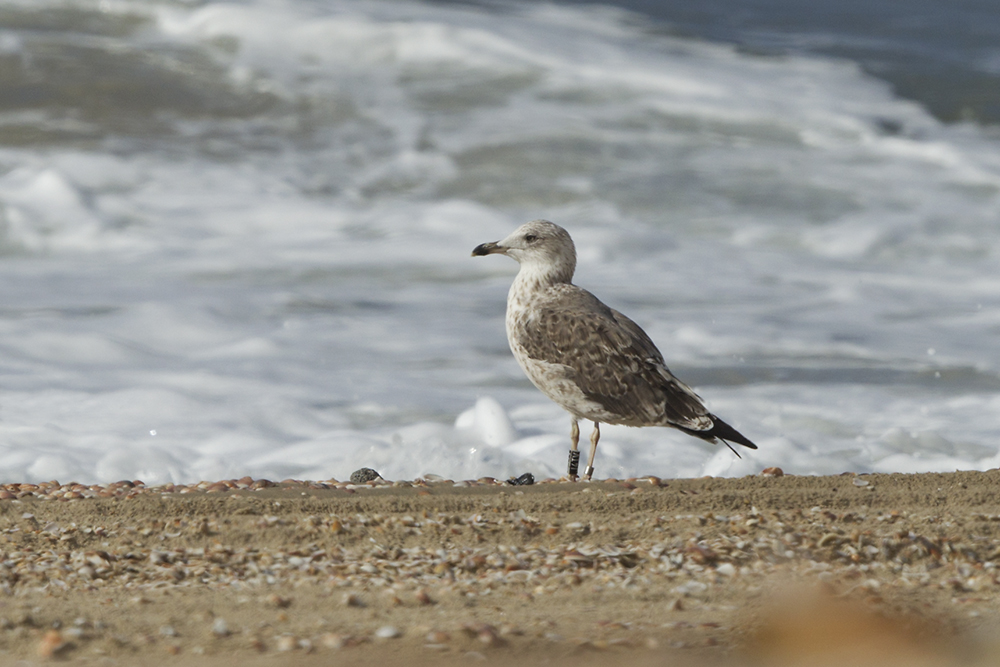
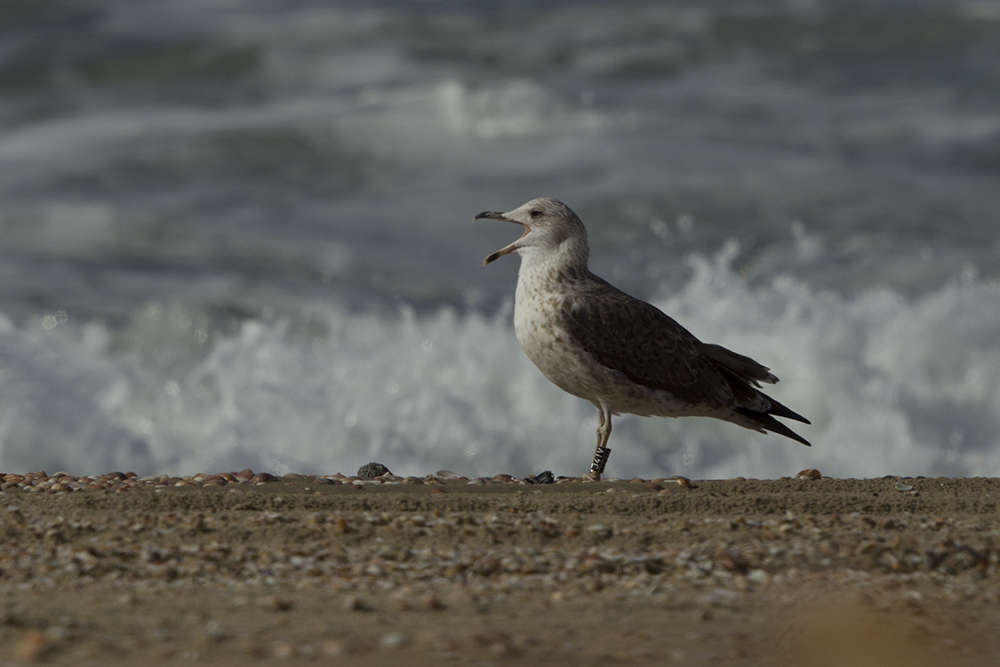


below: 3CY J4TV September 13 2013, Ashdod, Israel. Picture Amir Ben Dov.
Norwegian ringed bird turning up in Israel. When compared to other fuscus present, bird seems to be on the pale end of the variation. Also, moult timing and plumage-wise, this looks good for 3cy intermedius. Pattern on coverts and first indication of shade of grey coming through in the scapulars point to a bird that probably will not be very blackish within a few years when it will be adult. Also, the quality of the primaries seem to indicate that they were replaced recently, in line with what you expect for intermedius.
Remember that 2cy birds from the fuscus heartland (SW Finland) may show a similar patterned wing-covert panel and that such birds may sometimes be surprisingly pale as well.
It points us again to the question: "what exactly is the definition for fuscus and what is it intermedius?". Or "what is the acceptable individual variation for nominate fuscus?".
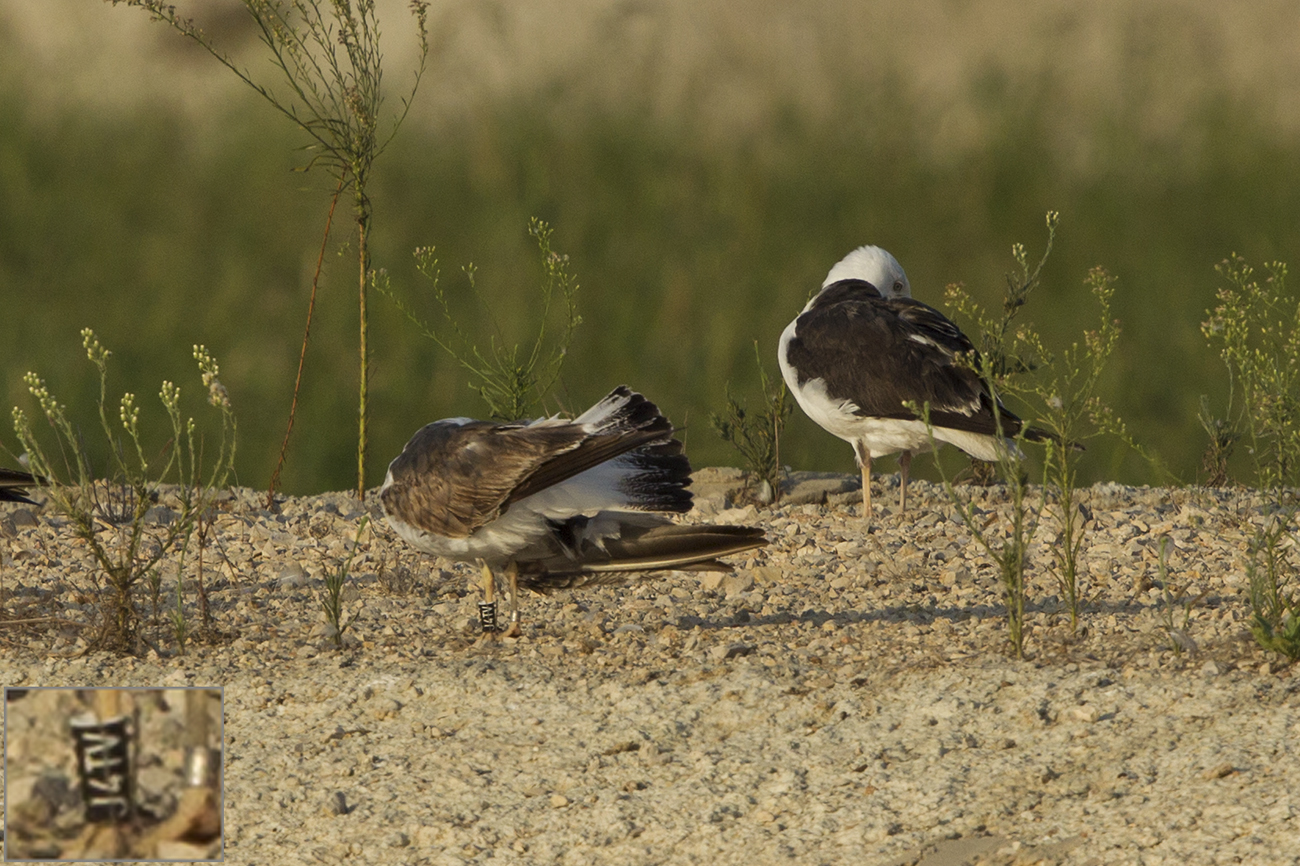
below: 3CY J4TV October 18 2013, Ashdod, Israel. Picture Amir Ben Dov.
Bird in complete moult, replacing the central primaries. Secondaries of old 2nd gen type.


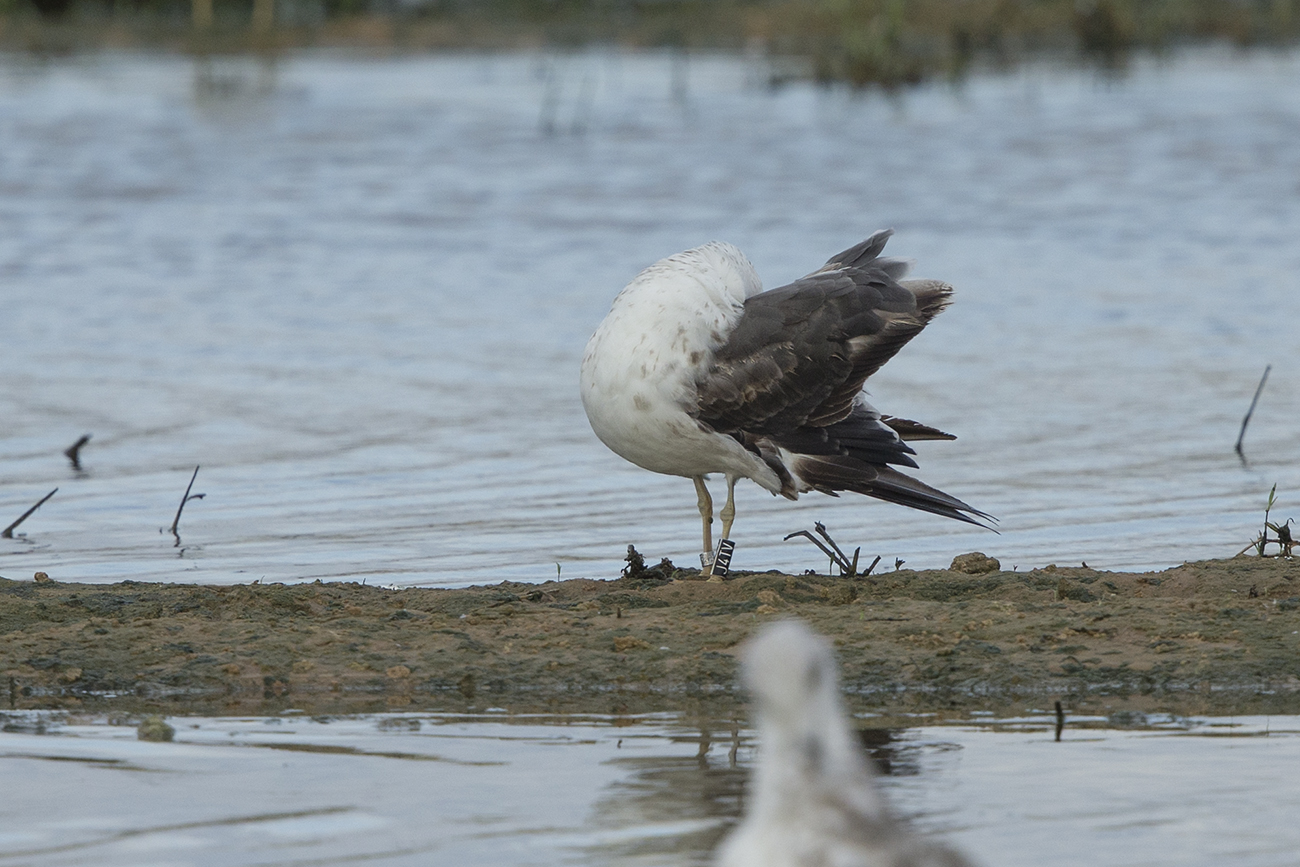
below: 4CY J4TV February 01 2014, Ashdod, Israel. Picture Amir Ben Dov.
Again black in tail.
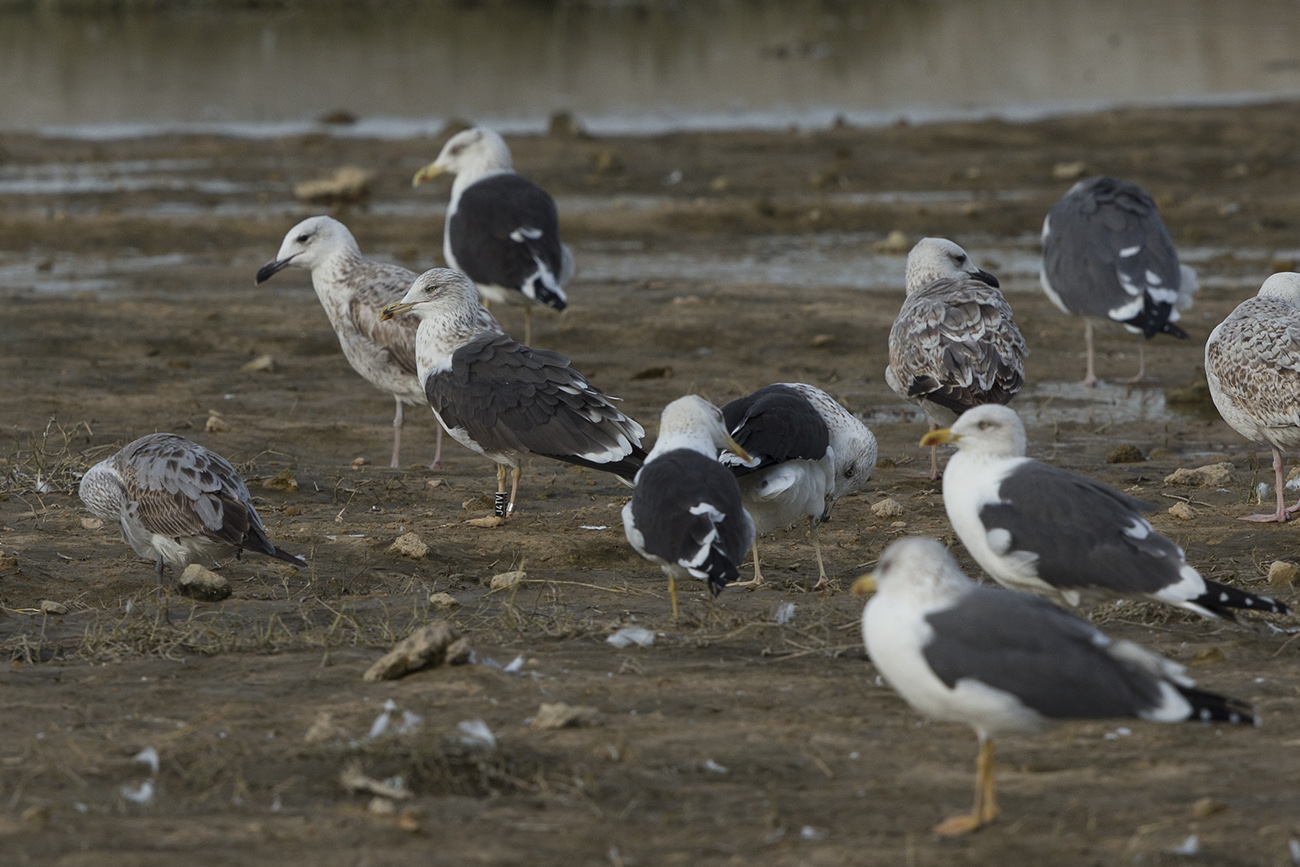
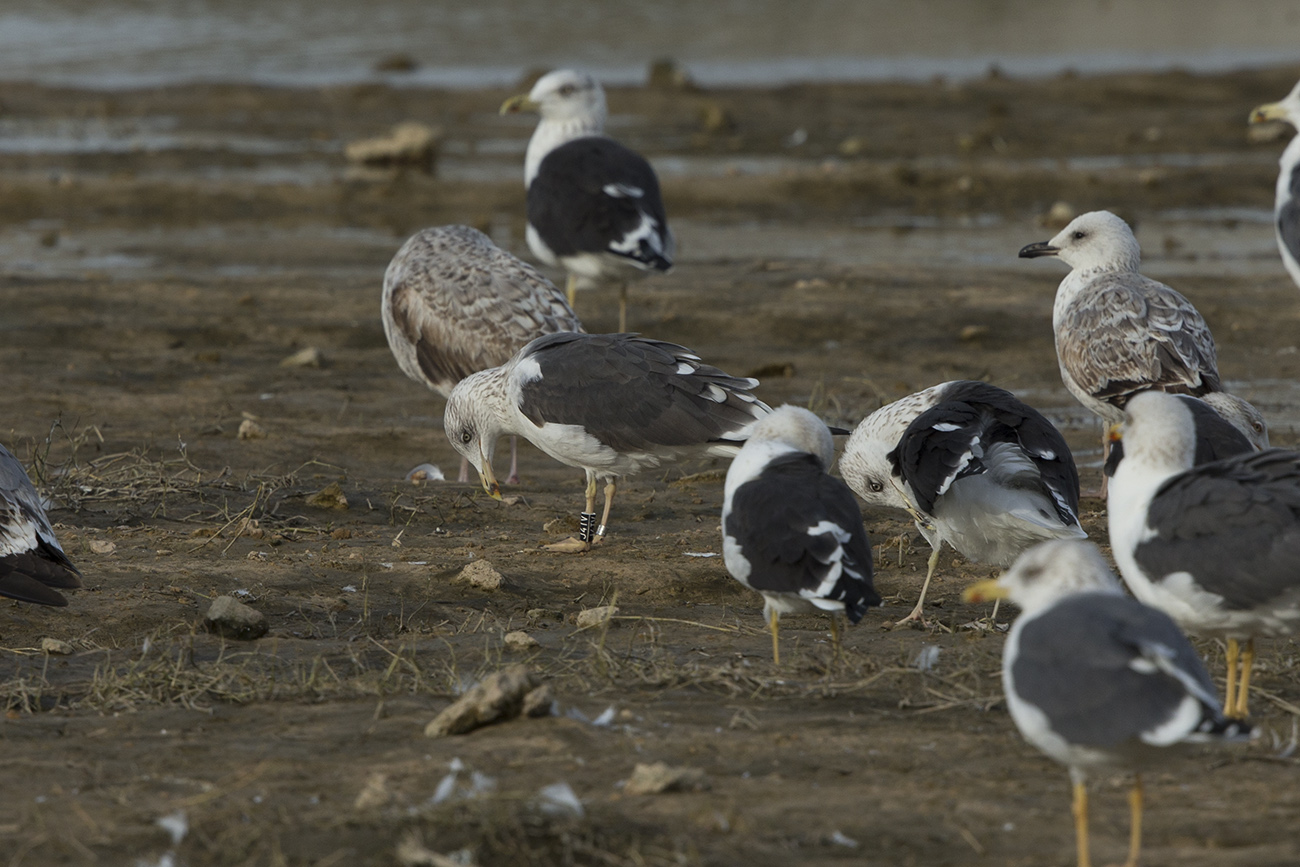
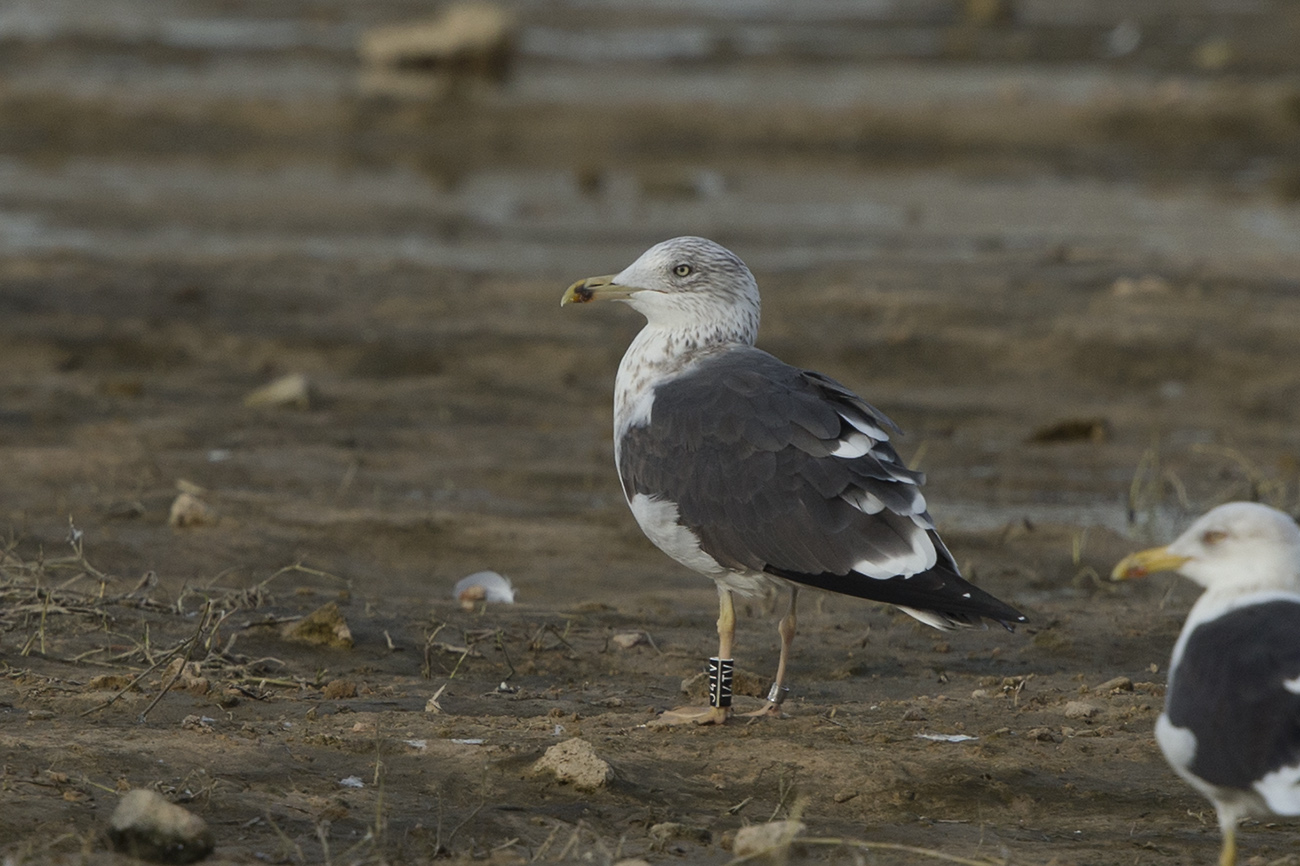
below: 4CY J4TV October 09 2014, Ashdod, Israel. Picture Amir Ben Dov.
P5-P10 old. P1 new, P2-P4 missing/growing. Black in tail.
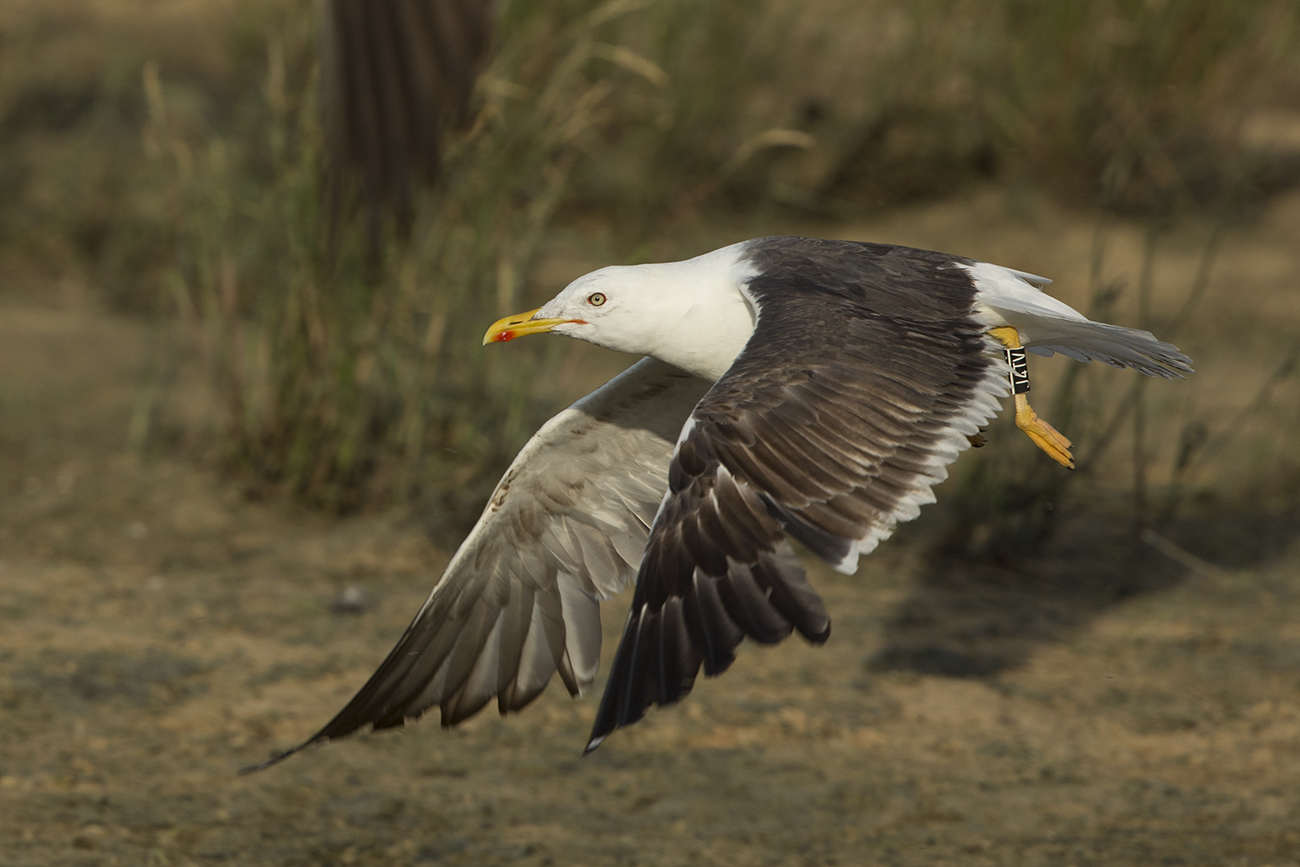

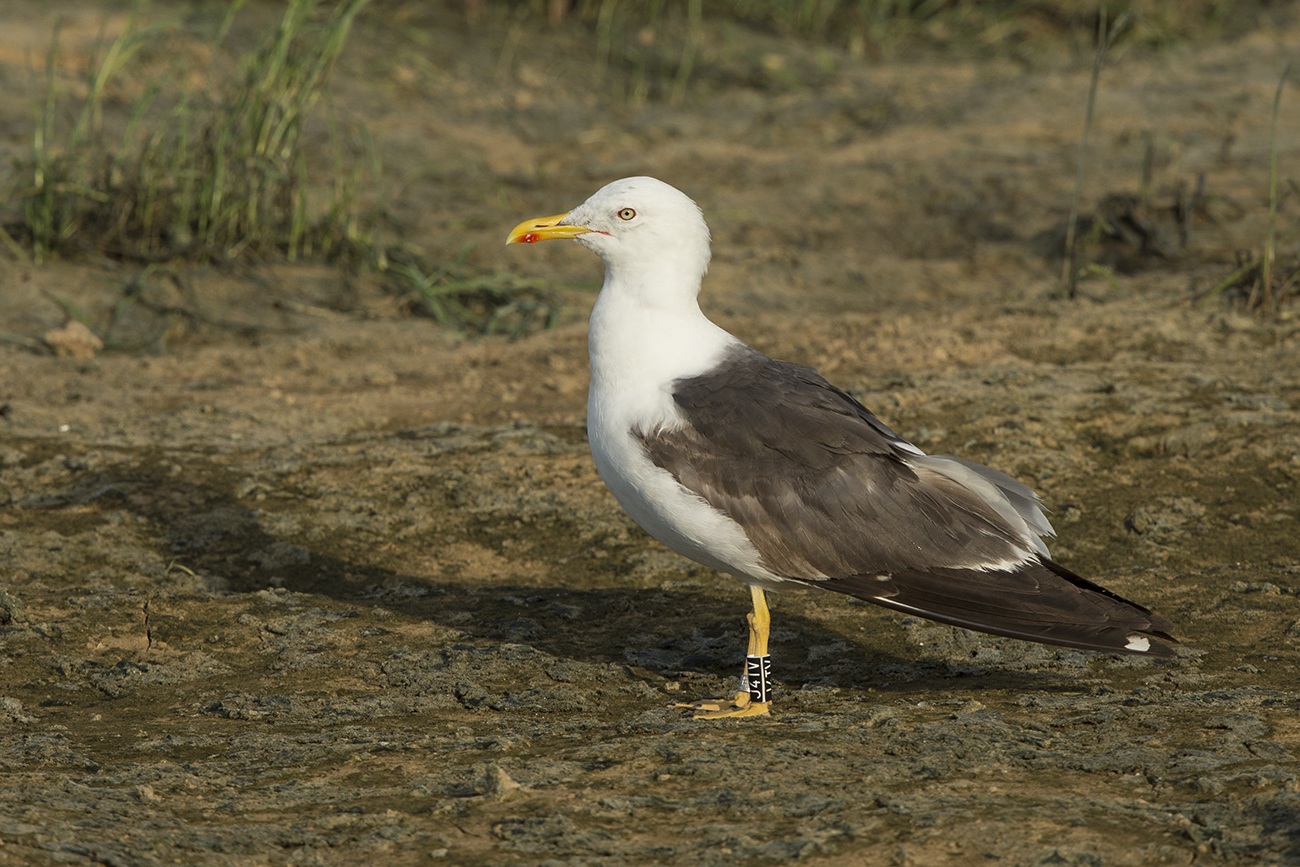
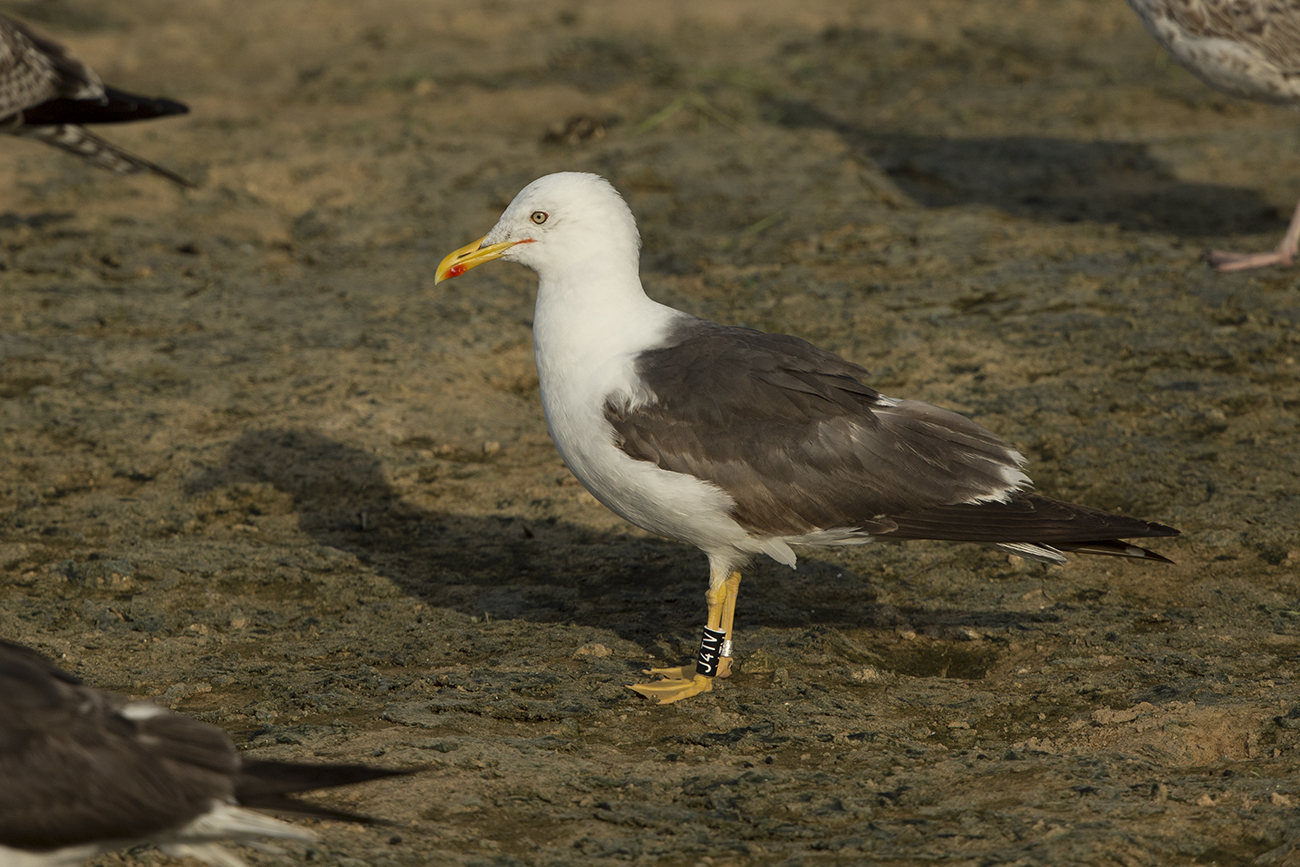
In all North Norwegian colonies there seems to be both pale and dark birds, and they are relatively shy and not used to humans, so studies like in central Europe, including southern Norway, are not straightforward. Then it is not easy to answer questions like "to what degree are there interbreeding between dark and pale birds". Or "who breeds late and which birds breed early", or to evaluate for example differences in breeding performance. Even to decide which chick belongs to which parents / nest are difficult questions in this areas. But there are for example 60+ pairs at Loppa, and Morten Helberg and collegues go back every summer to check colonies.
Below a picture by Morten Helberg, birds ringed at Loppa in 2012. JE9H was seen in Israel, JE6H in Italy, and JE2J, JE6J og JE8J near Madrid. JN5X was recorded by Foued in Tunisia, this birds was found exhausted in the colony in August 2013. All these birds have been trapped as breeding birds at the nest, but the partners are not known.
Morten sees mixed pairs of pale and dark birds together from time to time in spring, but that time they still have no ringed chicks, hence no provenance for true hybrids. But it is very probable that ringed hybrid chicks fly around, because Morten and collegues have ringed 1319 of them, and also 96 adults in Troms and Finnmark. Well-known J0X0 is illustrative as a good hybrid candidate, but with unknown parents.
